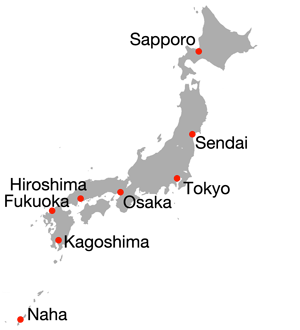Next Stop, Japan
When to Go to Japan

Japan's best travel months for most destinations are March, April, May, October and November. June is normally when the rainy season hits. This period of day-after-day rain leaves people in Japan housebound and bored until the weather pattern breaks. The merciless summer heat and humidity in August is great for beach lovers, but quickly drains your energy if you need to be walking around.
The extreme ends offer places to go even during the off months. Sapporo and the rest of Hokkaido is quite pleasant during the summer months because it lacks the typhoon and rainy seasons that plague other parts of Japan. Okinawa (Naha) and even the southern end of Kyushu (Kagoshima) stays warm during the winter.
Climate Graphs
The sample cities are sorted in the menu approximately from the southwest to the northeast. In most areas, June has the most rain days (≥5 mm).
Min and Max Temperature by Month
Average Rainfall by Month
Planning your Visit by Season
Most of Japan has distinct four seasons. The climate ranges from quite tropical in the south to temperate in the north. Japanese people follow the seasons are closely and match their dress and behaviour to them. Business men will all (regardless of the heat leading up to the date) switch over to summer suits almost all on the same day.
Winter December to February
The period after New Years can be chilly, but is normally dry and sunny. Also, sightseeing spots are free of crowds. The downsides are short days (earliest sunset in Tokyo is around 5 pm) and scenery is drab and dull. The peak of winter sports occurs in February. Hokkaido and inland hills (especially on the Sea of Japan side of Honshu) experience heavy snowfall.
What to pack: A nice jacket and warm clothes. Unless you're heading to the mountains or Hokkaido, don't pack for snow or much below freezing.
Spring March To May
As the plants come to life, so to does tourism both domestic and foreign. Winter sports wrap up in early spring except up in snowy Hokkaido. This period is considered by many to be the best time to visit Japan. April is cherry blossom season. The crush of Golden Week at the start of May is best avoided, but the rest of the month is quite warm and not as damp as it will get during summer.
What to pack: Jeans and t-shirts would work for most places in spring. Leave the jackets at home if arriving after mid-March and just pack some light rain gear.
Summer June to August
The archipelago begins the summer with the rainy season that occurs between June and mid July. The duration and intensity of the rainy season changes from year-to-year. Normally, June is quite overcast. After the rainy season ends, the hot and humid true summer begins. July and August are when a great number of local festivals occur. The fireworks and markets at the festivals are the reward for sweating buckets during the day. Hokkaido is again the exception as it does not have a rainy season. Many outdoor enthusiasts head there escape the showers and heat in the rest of Japan.
What to pack: Bring light cotton shirts and light pants or shorts. Cheap umbrellas are available everywhere. Buy one or bring a rain shell if you'll find that more convenient.
Fall September to November
The end of summer marks the start of typhoon season that lasts into the early fall. Although unpredictable, the storms rage mostly against Okinawa and southern parts of Kyushu and Shikoku. Where they do make landfall, transportation disruptions are common for the two or so days that they batter a region with high winds and rain. Good weather generally follows a typhoon. October is one of the most pleasant times to visit Japan. Tourist numbers drop off except in areas that are popular for leaf viewing. As it depends on altitude, latitude and type, trees can be found turning color right till the end of November.
What to pack: It can remain hot well into October. Later in November, bring a light jacket.
Top 3 worst times to travel to Japan
- New Year's
- The end of December to January 4 is a busy domestic travel time and when most attractions that are otherwise open year-round take a day or two off. Plus, New Year's is a fairly private affair without the large street parties and fireworks that are found in other countries.
- Golden Week
- The week from April 29 to May 5 has four public holidays. The transportation chaos is predicable, but still nobody in Japan seems to be able to resist taking advantage of the warming and improving weather.
- Obon Festival
- This occurs for about a week in mid-August. It's hot and many people take off on vacation. Often this is just to visit family, but the peak travel times jam the trains and highways.
An honourable mention goes to the school summer vacation, from around July 19 or 20 through August. This mainly affects attractions like amusement parks that overflow with kids the minute the final chime rings.
Posted: August 1, 2015 Updated: January 24, 2016